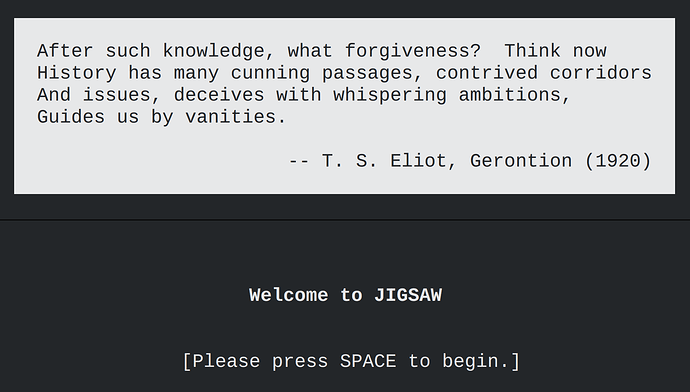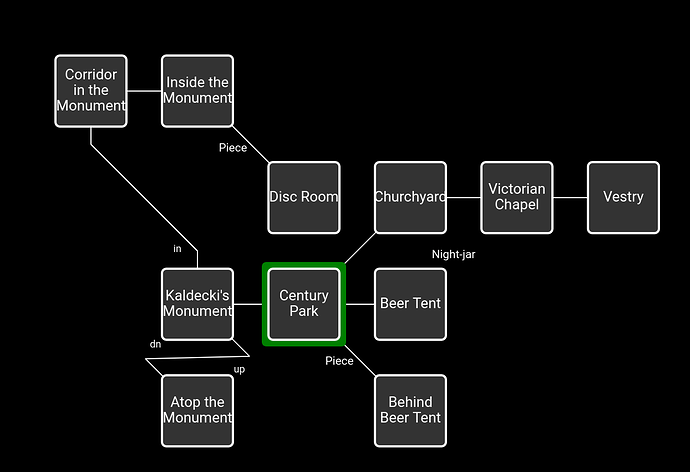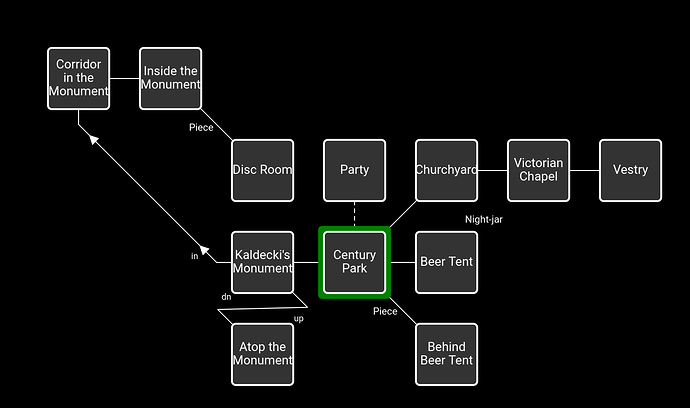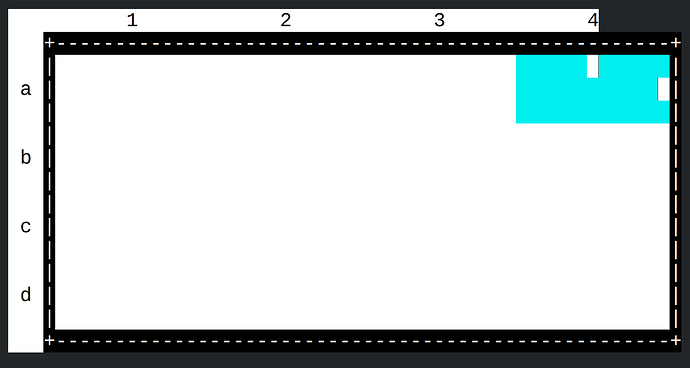Back in Century Park. North is the crowd, east is the beer tent, southeast is the dumping ground, and we can’t go northwest, southwest, up, or down (though each one has a custom message, which is neat).
That leaves northeast and west. Let’s try northeast first.
Churchyard
A few remains of fences and a crumbling wall are all that divides the overgrown edge of the Park from this long-neglected churchyard, serene and dappled with blacks and greens. Ivy and brambles curl their slow arms around the stones, and the door of the Victorian red-brick chapel (to the east) has gone altogether.
A night-jar flutters from perch to perch along an old iron fence.
Aw, cute!
And more importantly, this place seems nice and dark and quiet. Plus it has a good aesthetic. Our headache abates a little, and our desire to explore new places can finally outweigh our desire for peace and quiet. (I don’t know about you all, but I would definitely spend the entire party poking around in a place like this.)
What’s in that chapel?
Victorian Chapel
An odour compounded of desiccated, pressed flowers, incense and wax makes you feel somehow rested in this modest and now deconsecrated chapel. The old brass fittings and altar have been stripped, and the vestry to the east is heaped with debris.
In pride of place is a shocking modern-art statue of a man, and it is a kind of collage. He has an air-raid warden’s helmet, a sickle in one hand, a soldering iron in the other: an old-fashioned cavalry officer’s tunic and a pair of miner’s trousers, then Indian sandals.
See, we’re feeling rested now! The made-up motivations I’m ascribing to our protagonist aren’t entirely out of place!
> x statue
Written around the base, in large Roman letters, is: “Grad Kaldecki, 1917-95: Inventor, Sculptor, Philanthropist”, and his motto: “felix qui potuit rerum cognoscere causas”.
Nelson really does love his Latin quotes. This one’s Vergil: “Happy is he who can understand the causes of things.” Or, if you prefer a more poetic translation, a bit of googling gave me “happy the man, who, studying nature’s laws, through known effects can trace the secret cause”. I don’t recognize the name “Kaldecki”, though I’ve asked my Hungarian-knowing sister and my Polish-knowing friend if it fits either of those languages. This might be our Eastern European.
EDIT: The friend says “Grad Kaldecki” does sound Polish, and “Grad” is a not-too-obscure given name.
Let’s keep exploring!
Vestry
The vestry once held surplices. Today, it holds a surplus. Debris, broken furniture, blown-in leaves, panes of dusty glass and mildewed cloth, all unwanted.
There’s even an old Victorian piano stool, but no sign of a piano.
Booooo. That’s a bad pun even for me.
Maybe we can…look under this stool?
> look under stool
There’s a charcoal pencil underneath the stool.
Aha! And maybe…what if we…look inside it?
> look in stool
In the piano stool is Emily’s sketch book.
Just idle curiosity. We definitely won’t get locked out of the game at the very end if we fail to find and pick up these two unclued items.
An old child’s sketch book, pages of cartridge paper sewn up in cloth binding. On the front, in faded copper-plate handwriting, is written “Emily’s Animals Book”.
Emily has yet to sketch anything in it, though.
Or if we fail to realize that this is a book for sketching animals in. Definitely not.
There is a sudden roar from the crowd. Five minutes to midnight!
We’re almost feeling energized enough to go back and face the crowds. And maybe find someone to kiss at midnight. You never know. This party might be looking up after all.
Just gonna do one more thing first, to make sure the headache is gone.
> sketch night-jar
You sketch in a picture of the night-jar, with a curious sense of deja-vu, and the feeling that drawing such pictures is somehow a worthwhile aim.
It’s definitely a worthwhile aim—it helps us center ourselves and prepare to deal with crowds and cheering and the smell of beer and vomit everywhere! (And might allow us to win the game, too.)
We can head back southwest, and—
This party is giving you a headache.
Dammit. Okay. Let’s hide from society a little bit longer. Wonder what’s over to the west?
Kaldecki’s Monument
A corner of the Park, beside copses of trees and some fencing. Standing about here is the outdoor equivalent to always being in the kitchen at parties.
The pyramidal Monument, built by the (very eccentric) Hungarian who laid out the park, dominates this corner. It isn’t very pleasing to the eye. Although the party’s organisers planned to bounce flashy lasers off the tip, somehow they don’t seem to have got round to it.
Ah, so he’s Hungarian, not Polish. That settles that matter. Just nicely polishes it off.
*ducks flying objects*
This also indicates that Century Park isn’t a real place, and isn’t just a failure of my Googling ability. As far as I can tell Grad Kaldecki is entirely fictional.
Well, if we’re not going to go kiss that stranger at midnight, we might as well do something fun.
> climb monument
Atop the Monument
The anticipated good-view-of-the-party is spoiled somewhat by the perilous nature of the footing - on a sharp triangular wedge of metal. “exegi monumentum aere perennius,” says an inscription. Let’s hope so.
Poking out of the top of the monument is a rickety lightning-conductor.
Nelson—er, Kaldecki—really likes his Latin quotes. This one’s a pun: it’s the start of the final work of the poet Horace, and means “I have built a monument/legacy more lasting than bronze”, referring to his poems. Except here, Kaldecki’s writing it on an actual monument, which is made of steel, which is more lasting than bronze. I’m sure it’s very funny once it’s explained like this.
(Well, it was supposed to be his final work, but then a decade later he went back and published some more poetry, about getting old and no longer being attractive to the handsome young men he wants to woo, and also how amazing and wonderful Augustus Caesar is. In my opinion they’re not as good.)
Anyway! What’s this lightning rod thing all about?
> x conductor
Made of very thin fuse wire, the kind which would practically melt on a hot day, which seems highly inappropriate for a lightning conductor.
A fuse, you say.
> i
You are carrying:
…
a sparkler (providing light)
>:]
> light fuse
(with the sparkler)
The fuse wire in the lightning rod begins to burn down. It shrivels away with a disappointing fizzing sound, and then the whole monument is rocked slightly by a bang from within. A little smoke rises from the base.
[Your score has just gone up by one point.]
Now this is a party.
The explosion seems to have opened a “charred and saw-toothed doorway” in the side of the monument, and once again our curiosity gets the better of us.
Corridor in the Monument
A short metal corridor running along the inside of one wall of the pyramid, and sloping slightly inward. The scene out through the south entrance is perfectly, even alarmingly still. The far end turns and opens inside to the east.
Mounted on the inner wall is a glass display case.
As soon as we go in, the status line changes from “Time: 11:59 PM” to “6/0/44”, whatever that means. June 0th, 1944?
> score
You have so far scored 6 out of a possible 100, in 44 turns, giving you the rank of Partygoer.
Oh. Or that. Let’s go back out and see what’s—
> s
Some kind of invisible wall blocks the doorway. Through it you can see absolute stillness, smoke hanging rigid as if photographed.
…concerning.
The display case is sealed with “an elaborate, carved metal lock”, so be on the lookout for elaborate, carved metal keys.
Inside the Monument
A sloping crevice of metal, sunken into the ground some way to make a larger-than-expected room. Short flights of steps lead up to west and southeast. The air is frigid.
At the centre is a heavy old table, as grimy as the rest of this cavity, a thick layer of dust shadowing its beautiful marquetry.
On a kind of steel mantelpiece sits a late Victorian ormolu clock, with a curious single hand on the sixty-minute dial, pointed upwards in the zero position.
“Ormolu” comes from French or moulu “ground-up gold”, and refers to a way of coating an object with gold: you mix gold with mercury (to make what Hadean Lands players would call a “gold amalgam”), coat your bronze object with it, and heat it in a kiln so the mercury evaporates and leaves the gold behind. This lets you gild very fine details without much effort, but also means everyone near the kiln is breathing mercury vapor, so it got banned in the mid-1800s.
> x clock
The ormolu clock sits on the mantelpiece, but might well be portable. On the base of the ormolu clock is engraved “Labuntur et imputantur” together with the maker’s mark (William Snelson the Clockmaker). Via clockwork you can set the position of the single hand, and around the back is a small latch with two positions: to judge from the engraved icons, alarm on and alarm off. Presently, the latch is on.
The clock stands at 0.
“They fall away, but they are accounted for”, where “they” is presumably hours (or time in general). This one’s the title of a poem (in English) by Ciaran Carson.
Let’s look under that table to satisfy our idle curiosity, while we’re at it.
With all jigsaw puzzles, no matter how careful you are a piece always ends up on the floor. With a judicious kick you manage to push this one clear of the table.
Good thing we didn’t miss this!
> se
Disc Room
This is a tiny tetrahedral annexe of a room, whose only clear feature is a broad black disc embedded in the floor.
> x disc
The disc is jet black and about six feet in diameter. Around the circumference is inscribed “rari nantes in gurgite vasto”.
“Rare swimmers in the vast whirlpool”. Or, more idiomatically, “some rare survivors in the vast sea”. Vergil again.
Let’s check out the table; that will be a good conclusion to this post.
> x table
A heavy old table, high and wide over a doubtless dusty floor, with fine inlaid marquetry decoration. On one side is a brass plaque, declaring it to be “by Mr Gm. Nelson, begun at the Holywell Stables, MCMXCIII; completed at the Waynflete and Summertown, MCMVC”.
Started 1993, completed 1995. That tracks. I’m guessing these are places where the author was staying while working on this game.
This dust is making the migraine worse again, though. Let’s get rid of it.
> clean table
The table comes up a shine. On top of it seems to be a some kind of frame, or board, which perhaps bears further examination.
[Your score has just gone up by one point.]
> x frame
A four-by-four square grid of mahogany, with gold leaf inscriptions denoting the squares “a1” to “d4”, and giving the Latin tag “nec deus intersit nisi dignus vindice nodus inciderit”.
[Note: to put a jigsaw piece onto the frame, try “put piece at c3”, for instance: if it won’t fit, try turning it first. To get one back again, try “take c3”. To look at a played piece, try “examine c3”. Pieces are displayed in a chequerboard-style for contrast on your computer’s screen, and their colour has no game significance. Try “style 1” for b/w, “style 2” for a spartan look and “style 3” for colour (on some machines only).]
“That a god should not intervene, unless a knot happens that’s worthy of such a savior.” Google tells me this one is Horace again, basically a warning not to solve all your narrative problems with a deus ex machina.
And that seems like a good place to stop and rest a little bit. Time is paused in the world outside, after all. We can take a nap and get rid of this migraine without missing the ball drop.
We’ve reached the end of the prologue, and tomorrow (or whenever I resume this), we’ll get into the meat of the game itself!
Full transcript and save file, as is tradition:
01.txt (18.6 KB)
01.sav (960 Bytes)






